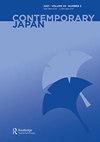Uniformity or polarization? The nuclear power debate in Japanese newspapers and political coalitions, 1973–2014
引用次数: 5
Abstract
ABSTRACT The image of Japanese mainstream media reporting is dominated by the institution of “press clubs”. Critical researchers argue that these restricted and institutionalized links between mainstream media and their sources lead to uniformity in media reporting. Other researchers contend that Japanese journalists play diverse roles and frame issues in diverse ways. These contrasting theses are explored through an analysis of three major newspaper's framing of nuclear power in article series (rensai). First, we construct a set of frames of the nuclear power issue out of materials from two political alliances: the pronuclear alliance (the so called “nuclear village”), and the antinuclear alliance. We apply and adapt these frames using a sample of newspaper article series from 1973 to 2014. The comparison shows that there are significant differences of reporting both between newspaper organizations as well as between different periods. Especially for the phase after 2011, reporting turns pronouncedly nuclear-skeptical in two newspapers. While not denying press club influence, the analysis cautions against mechanically applying a distinction between “insider” and “outsider” media and calls for new analytical categories to explain the substantial differences of framing between journalists of various “insider” media organizations.均匀还是极化?1973-2014年,日本报纸和政治联盟中的核电辩论
摘要日本主流媒体报道的形象是由“新闻俱乐部”制度主导的。批判性研究人员认为,主流媒体与其来源之间的这些限制性和制度化的联系导致了媒体报道的一致性。其他研究人员认为,日本记者扮演着不同的角色,以不同的方式报道问题。本文通过对三大报纸在《仁赛》系列文章中对核电的框架分析,探讨了这两篇具有鲜明对比的论文。首先,我们从两个政治联盟的材料中构建了一套核电问题的框架:原核联盟(所谓的“核村”)和反核联盟。我们使用1973年至2014年的报纸系列文章样本来应用和改编这些框架。比较表明,不同时期和不同报社的报道都存在显著差异。尤其是在2011年之后的阶段,两家报纸的报道明显转向了对核的怀疑。虽然不否认新闻俱乐部的影响,但该分析警告不要机械地区分“内部”和“外部”媒体,并呼吁建立新的分析类别来解释各种“内部”媒体组织的记者之间的框架差异。
本文章由计算机程序翻译,如有差异,请以英文原文为准。
求助全文
约1分钟内获得全文
求助全文

 求助内容:
求助内容: 应助结果提醒方式:
应助结果提醒方式:


